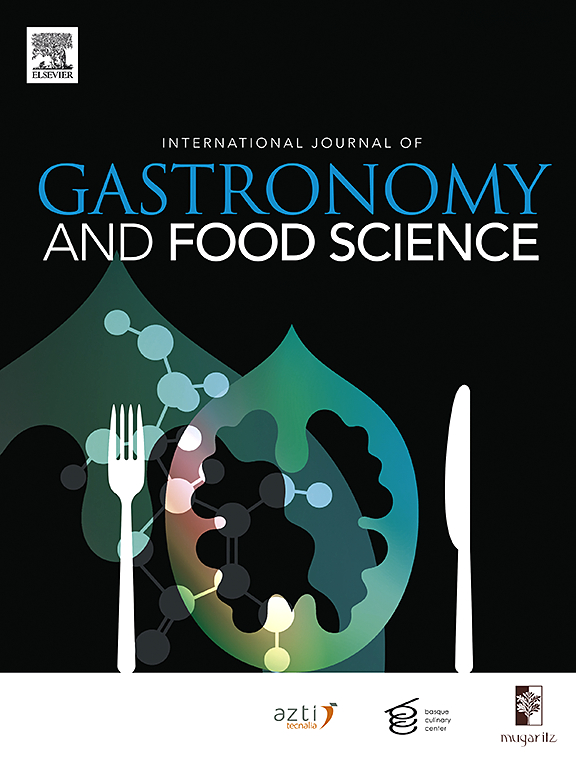Haute cuisine: A mixed-methods approach to assess gastronomic offer nutritional adequacy and importance given by chefs to food and nutrition guidelines
IF 3.6
2区 农林科学
Q2 FOOD SCIENCE & TECHNOLOGY
International Journal of Gastronomy and Food Science
Pub Date : 2024-10-10
DOI:10.1016/j.ijgfs.2024.101034
引用次数: 0
Abstract
In recent years, a growing interest of society for out-of-home food experiences has been observed, concurrently with an increasing number of restaurants associated to haute cuisine. However, data on the nutritional adequacy of the meals offered in these restaurants is lacking. This study aimed to evaluate the perception of haute cuisine chefs in Portugal about the importance attributed to food and nutrition recommendations when planning their gastronomic offer and to assess the nutritional adequacy of the meals offered in these restaurants. A mixed-methods, cross-sectional study was conducted, in which all chefs from Michelin star-awarded restaurants in Portugal, in accordance to the Michelin Guide 2022 edition, were eligible and invited to participate. A qualitative content analysis of semi-structured face-to-face individual interviews (n = 11 chefs) and a quantitative assessment of the nutritional composition of appetizers, main courses and desserts (n = 29 recipes) were conducted between January and June of 2022. The majority of chefs reported giving much importance to nutrition principles while planning their menus, also showing positive attitudes and opinions towards healthy food practices and future partnerships with nutritionists. However, knowledge and perceptions regarding nutrition concepts were, in general, inconsistent and unobjective. Recipes' median energy contents ranged between 549 kcal/serving in meat courses and 1594 kcal/serving in desserts, with total fat contribution at around or above 40% of total energy value (TEV). Median saturated fat contents varied between 14% and 21% of TEV in appetizers and desserts, respectively. Sugar contents were the highest in desserts (median: 49% of TEV). Salt was particularly high in seafood dishes (median: 12.9 g/serving). The recipes evaluated showed an inadequate nutritional profile, with energy, total fat, sugar and salt contents frequently above maximum recommendations. Strategies aimed at improving chefs’ culinary practices are needed, namely through the enhancement of their literacy and awareness regarding nutrition principles. Their openness to collaborate with nutrition specialists should be exploited as an opportunity for future interventions.
高级美食:采用混合方法评估美食提供的营养是否充足以及厨师对食品和营养指南的重视程度
近年来,随着与高级美食相关的餐厅数量不断增加,社会对户外美食体验的兴趣也与日俱增。然而,有关这些餐厅提供的膳食营养是否充足的数据却很缺乏。本研究旨在评估葡萄牙高级烹饪厨师在规划其美食产品时对食品和营养建议的重视程度,并评估这些餐厅所提供膳食的营养充足性。研究采用混合方法进行横断面研究,根据《米其林指南》2022 年版,葡萄牙所有米其林星级餐厅的厨师均符合条件并受邀参加。2022 年 1 月至 6 月期间,对半结构化面对面个人访谈(n = 11 名厨师)进行了定性内容分析,并对开胃菜、主菜和甜点(n = 29 份食谱)的营养成分进行了定量评估。大多数厨师都表示在制定菜谱时非常重视营养原则,并对健康饮食实践和未来与营养师的合作表现出积极的态度和看法。然而,他们对营养概念的认识和看法总体上并不一致,也不客观。食谱的能量含量中位数介于肉类菜肴的 549 千卡/份和甜点的 1594 千卡/份之间,总脂肪含量约占总能量值(TEV)的 40% 或以上。开胃菜和甜点的饱和脂肪含量中值分别为总能量值的 14% 和 21%。甜品中的糖含量最高(中位数:占 TEV 的 49%)。海鲜菜肴的含盐量尤其高(中位数:12.9 克/份)。所评估的食谱显示营养成分不足,能量、总脂肪、糖和盐的含量经常高于最高建议值。有必要制定旨在改进厨师烹饪方法的策略,即提高他们的营养知识水平和对营养原则的认识。应利用他们与营养专家合作的开放态度,为今后的干预措施提供机会。
本文章由计算机程序翻译,如有差异,请以英文原文为准。
求助全文
约1分钟内获得全文
求助全文
来源期刊

International Journal of Gastronomy and Food Science
Social Sciences-Cultural Studies
CiteScore
5.30
自引率
10.50%
发文量
170
审稿时长
45 days
期刊介绍:
International Journal of Gastronomy and Food Science is a peer-reviewed journal that explicitly focuses on the interface of food science and gastronomy. Articles focusing only on food science will not be considered. This journal equally encourages both scientists and chefs to publish original scientific papers, review articles and original culinary works. We seek articles with clear evidence of this interaction. From a scientific perspective, this publication aims to become the home for research from the whole community of food science and gastronomy.
IJGFS explores all aspects related to the growing field of the interaction of gastronomy and food science, in areas such as food chemistry, food technology and culinary techniques, food microbiology, genetics, sensory science, neuroscience, psychology, culinary concepts, culinary trends, and gastronomic experience (all the elements that contribute to the appreciation and enjoyment of the meal. Also relevant is research on science-based educational programs in gastronomy, anthropology, gastronomic history and food sociology. All these areas of knowledge are crucial to gastronomy, as they contribute to a better understanding of this broad term and its practical implications for science and society.
 求助内容:
求助内容: 应助结果提醒方式:
应助结果提醒方式:


